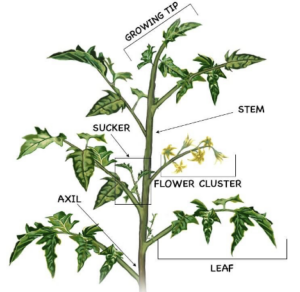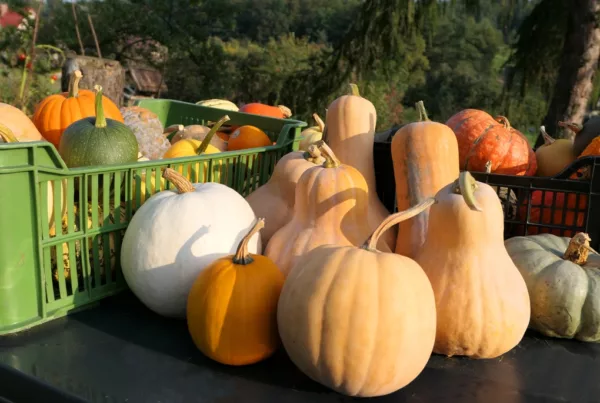
We’re all used to pruning plants like trees, shrubs, and flowering perennials, but tomatoes? If you’ve ever grown tomatoes in your vegetable garden, you know how easily they can take over their space with their jumbly growth. And with Square Foot Gardening, if a plant misbehaves and takes over its space, chances are pretty good that it will take over its neighbor’s space, as well. So, let’s learn some basics about pruning tomatoes to keep all the neighbors happy and healthy.
Determinate vs. Indeterminate Tomatoes
Okay, before we talk about the “how,” we need to quickly go over the “what” and the “why.” Determinate tomato plants produce their crop in a shorter period of time and are typically “bush” types that grow to about 3’ tall. So, we’re not talking about determinate tomatoes here — they are already more contained and well-behaved! (But speaking of determinate tomatoes, even though they are shorter with more easily managed growth, proper spacing at 1 bush tomato in a 2’x2’ square is recommended.) The only pruning that needs to be done for determinate varieties of tomatoes is to remove the leaf branches below the first fruit cluster after it appears. This will reduce the risk of soil splashing up onto the plants during rainfall, which can introduce fungal diseases. Determinate tomatoes can easily be supported with cages that are only 4’ tall. This will help keep the foliage and fruit off the soil.
Indeterminate tomatoes, on the other hand, are “vining” types that can grow up to 20’ (or more!) with branches looming out in every direction. They also produce the largest tomatoes, take longer to mature, and often stick around until the first frost. Because of their immense growth, indeterminate tomato plants require some sort of support system like staking or trellises. The usual cages that work for determinate tomato varieties won’t be tall enough for indeterminate varieties.
So, in this blog post, we’re talking about pruning indeterminate tomatoes to keep them in line and playing well with your other SFG plants.
Why we need to prune indeterminate tomatoes
You might wonder, if you’re planting your indeterminate or vining tomatoes on a trellis, why you’d need to prune them anyway. They’re already growing up, right? Let’s take a look at why it’s not only helpful but often necessary:
- Garden tidiness. SFG recommends planting one indeterminate tomato per square in the grid. We’re assuming you’re attaching your trellis to the north end of your raised bed and that the tomato is planted in those adjacent squares. The side growth, or suckers, on your tomato plant will always want to grow out rather than up, taking over other squares — so pruning them early on keeps squares distinct and the garden tidy. We love a tidy garden, don’t we?
- Proper air circulation. Plants with growth that is overgrown and crowded often have poor air circulation, which can lead to all manner of problems in the garden like mildew, rust, and fungal diseases.
- Garden maintenance. If your plants are so overgrown and you can hardly see your grids on top of the soil, it’ll be pretty tough to maintain and water your garden — and let’s not forget that sticking your arms into out-of-control tomato foliage can often irritate sensitive skin! Proper tomato pruning eliminates all of these hassles so working in your SFG is even more pleasant.
- Plant vigor. When you prune off those side suckers, your tomato plant can grow stronger and healthier. Why? Because those side branches (suckers) will eventually grow so long that they will take energy away from the main vertical branches and overall plant. And while more stems might mean more tomatoes, those additional tomatoes are often smaller and less tasty.
How to prune your indeterminate tomato plants
Now you might ask, “I can’t prune off all the side branches, that would leave only one stem, right?” Right! What we’re talking about here are the suckers, which grow out at an angle at the axils between the leaves and the main stem, and the side branches underneath the first flower cluster. Try to prune frequently enough to keep only a single main stem, or at most two stems. Here’s how to do it:
- Plant your tomato plant by the trellis, but do not tie it to the trellis until the first flower appears.
- Once the plant has its first flower cluster, prune off any side branches below that cluster.
- On side branches that develop above the first cluster of flowers, keep an eye out for suckers and prune them off as well. Suckers grow out at an angle from where the main stem and side branch connect.
- Towards the end of the summer, consider topping or pruning the top part of your tomato plant — this can invigorate the plant into producing a late season harvest. It will also allow the plant to put its energy into maturing the existing fruit before the first frost.
Fun Kids Activity: Take a couple of the suckers and side branches you just pruned, and have your kids place one in a large cup of water and the other in a large cup of moistened vermiculite. Keep the vermiculite moist, and once a week, the kids can remove the branches and compare root growth between the two growing mediums. Encourage them to take notes and notice other differences. If this is done when it is still the proper planting time for tomatoes in your area, these suckers can be planted to have even more tomato plants.



